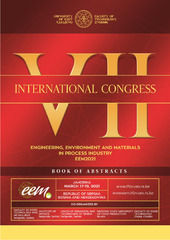Приказ основних података о документу
Removal of diesel pollution by biochar – support in water remediation
| dc.contributor | Gligorić, Miladin | |
| dc.contributor | Vujadinović, Dragan | |
| dc.contributor | Beribaka, Mirjana | |
| dc.creator | Lopičić, Zorica | |
| dc.creator | Avdalović, Jelena | |
| dc.creator | Milojković, Jelena | |
| dc.creator | Antanasković, Anja | |
| dc.creator | Lješević, Marija | |
| dc.creator | Lugonja, Nikoleta | |
| dc.creator | Šoštarić, Tatjana | |
| dc.date.accessioned | 2023-10-12T10:43:56Z | |
| dc.date.available | 2023-10-12T10:43:56Z | |
| dc.date.issued | 2021 | |
| dc.identifier.isbn | 978-99955-81-38-1 | |
| dc.identifier.uri | https://ritnms.itnms.ac.rs/handle/123456789/888 | |
| dc.description.abstract | Water contaminated with diesel oil is one of the great challenges in waste water management. It is crucial to remove the water soluble fractions (WSF) from water in order to avoid toxic effects of these compounds and to meet the discharge regulations set by the environmental authorities. Biochar sorbents have generated a lot of attention as a new type of material due to their low cost origin and surface properties which lead to exceptionally high sorption capacities in water-pollution separation process. In this study, we have reported the synthesis and characteristics of novel biochar sorbent made from waste lignocellulosic biomass (peach stones) and evaluated its possible application in removal of WSF from synthetic wastewater. The synthesized biochar materials were characterized using scanning electron microscopy (SEM), Fourier (FTIR) and Brunauer, Emmett and Teller (BET) technique, while the elemental analysis was also done. Characterisation of peach stone biochar (PS-B) indicated multi porous high surface area (159.1 m2/g), with an average pore diameter of 2.66 nm. FTIR results indicated the presence of more aromatic compounds in biochar compared to peach stones. The sorption experiments were performed in batch system with mixing, with initial WSF of diesel components of 20 mg/L. The application of peach stone biochar (PS-B) resulted in more than 95% removal of diesel WSF, with reaching equilibrium after 5h of contact (under described operational conditions). Sorption mechanism can be described as multilayer chemisorption process, well described by Freundlich equation, which was also confirmed by pseudo-second order equation. Ecotoxicology tests have shown a decrease of toxicity of contaminated water on A. fischeri after the treatment of water by biochar sample. Therefore these forms of carbon based sorbents have great potential to be good sorbents of petroleum hydrocarbons WSF and can be successfully applied for their removal in water treatments | sr |
| dc.language.iso | en | sr |
| dc.publisher | Zvornik : University of East Sarajevo, Faculty of Technology | sr |
| dc.relation | info:eu-repo/grantAgreement/MESTD/inst-2020/200023/RS// | sr |
| dc.rights | openAccess | sr |
| dc.source | 7th International Congress “Engineering, Environment and Materials in Process Industry“ | sr |
| dc.subject | diesel | sr |
| dc.subject | WSF | sr |
| dc.subject | food processing waste | sr |
| dc.subject | biochar | sr |
| dc.subject | sorption | sr |
| dc.subject | ecotoxicology | sr |
| dc.title | Removal of diesel pollution by biochar – support in water remediation | sr |
| dc.type | conferenceObject | sr |
| dc.rights.license | ARR | sr |
| dc.citation.epage | 196 | |
| dc.citation.spage | 196 | |
| dc.identifier.fulltext | http://ritnms.itnms.ac.rs/bitstream/id/1391/bitstream_1391.pdf | |
| dc.type.version | publishedVersion | sr |

